
Transportation Investments Leads to Good Jobs
- Our nation’s transportation system depends on a skilled and qualified workforce equipped with a broader range of skills than in the past.
- Transportation accounts for 11 million jobs, and transportation-related employment accounts for about 8.7 percent of civilian workers in the United States.
- Every $1 billion in public infrastructure spending creates 13,000 jobs.
Transportation Jobs Creates Ladders of Opportunity for Communities
- Local and other geographic-based hiring preferences are essential to promoting Ladders of Opportunity for the workers in the communities where transportation projects are located.
- Transportation investments and policies can improve access to jobs, education, and goods movement, while providing construction and operations jobs.
- The choices that are made regarding transportation infrastructure can strengthen communities, create pathways to jobs and improve the quality of life for all Americans.
- The U.S. Department of Transportation provides over $51 billion in surface transportation construction funding each year to build our nation’s highways, bridges, and public transportation systems.
- Communities across the country have long sought the ability to leverage those funds into local jobs and economic growth.
- Federal rules make it hard for communities to ensure that their workers participate in the construction and operations jobs created by these projects.
Pilot Program
- This pilot program will enable the FTA and FHWA grantees, including states and local recipients and subrecipients, to utilize social and/or economic contracting requirements, such as a local or other geographic labor hiring preferences and economic-based labor hiring preferences (i.e., low- income workers), in order to evaluate the impacts to the competitive bidding process.
- Any project funded by FTA or FHWA can be considered for the pilot program. This includes construction projects, as well as rolling stock procurements. This one-year period is for contracts that will be advertised during this period.
- This initiative will be carried out as a pilot program for a period of 1 year (unless extended).
- To be eligible for this pilot program, contracts with these requirements must be advertised within this 1-year period. Contracts awarded under the pilot program may continue to utilize any approved contract requirements throughout the life of the project.
- After the conclusion of the pilot program, DOT will evaluate the impacts of any approved contract requirement and provide additional guidance on their potential use in the future.
Notice of Proposed Rulemaking (NPRM)
- DOT is also publishing an NPRM to propose amending the DOT’s implementation of the Common Grant Rule to permit all modal DOT recipients and sub-recipients to utilize geographic hiring provisions for labor on DOT-assisted projects when such use is otherwise consistent with applicable statutory authority.
GROW AMERICA
- To build on DOT’s progress to promote economic growth and workforce development, the Department proposed the GROW AMERICA Act, a reauthorization proposal for surface programs that would toughen Buy America rules that promote American manufacturing and reinforce fair wage provisions on transportation related projects. The bill also would invest $369 million in workforce development grants over six years to support and enhance the size, diversity, and skills of our nation’s transportation workforce.
Updated: Tuesday, May 12, 2015

